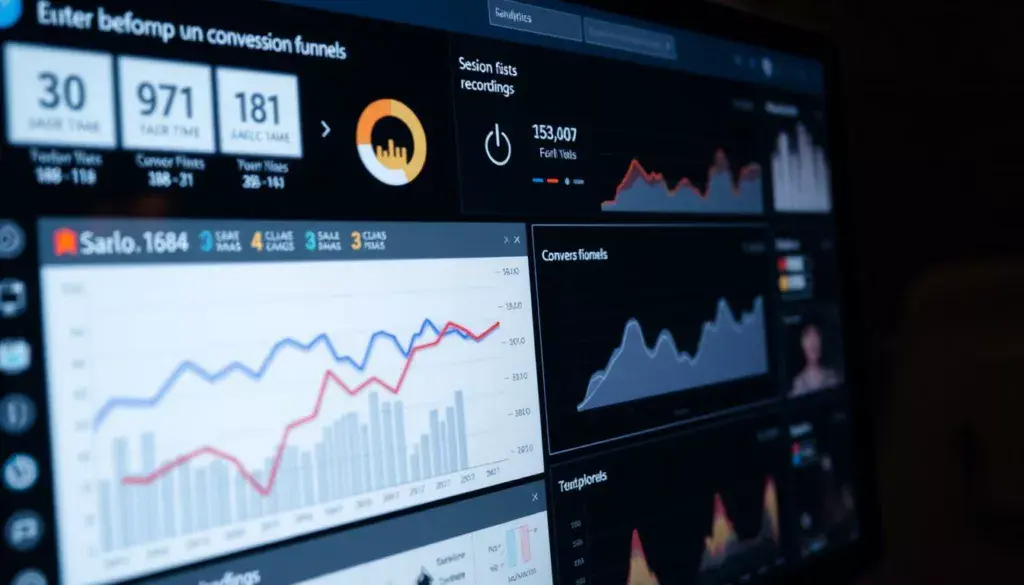
This guide explains how user behavior analytics become a strategic capability for security and product teams today. You will learn how tools set baselines for normal actions, spot subtle deviations in real time, and help teams act faster. Real-world data shows that valid account abuse is a top intrusion method, so looking at typical activity and context matters more than perimeter defenses alone.
Expect concise, practical coverage. We map core definitions, data pipelines, modeling techniques, and KPIs that matter to both cybersecurity and business stakeholders. The scope covers UBA/UEBA and product analytics, noting where methods align and where goals diverge.
Throughout, you will see examples of baselines, risk scoring, peer grouping, rules and machine learning, and integrations with IAM and response tools. The threat landscape demands intelligence-driven practices that reduce analyst toil and improve detection precision.
Key Takeaways
- Understanding normal patterns improves detection and cuts false alerts.
- Baselines, risk scores, and peer groups are core tools for timely response.
- Combining security and product insights boosts both protection and conversion.
- Valid account abuse makes context and continuous monitoring essential.
- Practical KPIs link detection outcomes to business and ops goals.
Understanding the fundamentals: UBA, UEBA, and where user behavior analytics fits today
Begin with a clear definition: we model normal actions for people and devices, then flag deviations that matter.
What this method means in security and product work
In cybersecurity, user behavior analytics models normal behavior for accounts and groups to surface risky activity in real time. It compares recent events to baselines and highlights deviations that merit investigation.
In product analytics, the same methods help teams see what users do and why, guiding UX fixes and conversion tests.
Why the extra “E” matters
UEBA adds entities such as apps, routers, servers, endpoints, and IoT. Adding device and application signals lets teams correlate human actions with machine telemetry across the stack.
That context can change conclusions. For example, a spike in a branch server’s request volume combined with unusual downloads from an account can indicate a coordinated incident.
| Feature | UBA | UEBA | Benefit |
|---|---|---|---|
| Scope | People and accounts | People + entities (devices/apps) | Richer context for alerts |
| Signals | Login times, access events | Plus telemetry: network, endpoint, app logs | Cross-correlation across systems |
| Detection | Deviation from personal baselines | Deviation across peers and machines | Higher precision and fewer false positives |
Origins and architectural fit
These solutions evolved alongside SIEM and EDR to fill gaps in context. Many platforms embed these capabilities to enrich events and tune alert fidelity.
“Profiling normal behavior for accounts and entities reduces noise and speeds triage.”
User behavior analytics: how it works from data collection to detection
A practical pipeline ingests identity, log, and network feeds to build a living baseline for each account and peer group.

Data sources that feed detection
Platforms collect identity context from directories like Microsoft Active Directory, and access records from IAM systems. They also ingest SIEM and EDR event streams, endpoint and application logs, file and database telemetry, and network traffic for flow-level visibility.
Baselines, identity consolidation, and scoring
Models learn normal behavior per person and across peer groups by accounting for roles, locations, access times, and resource use.
Multiple accounts for the same person are unified into one identity to avoid fragmented signals. Deviations raise a risk score based on severity and frequency.
Alerting and tuning
Thresholds trigger alerts into dashboards or SIEMs to prioritize triage and reduce noise. Continuous collection captures fast anomalies and slow drifts in near real time.
“Unusual access outside typical hours or large downloads from sensitive repositories should lift risk immediately.”
- Tune pipelines and identity mapping.
- Calibrate thresholds to local variance and acceptable risk.
- Monitor cadence to balance sensitivity and noise.
Analytics techniques that power detection: rules, ML, peer comparisons, and threat intelligence
Detection systems combine deterministic rules and adaptive models to spot policy violations and subtle risks.

Rule-based detection for policy and access anomalies
Rules catch clear violations fast. They flag privilege escalations, off-limits access attempts, and geolocation anomalies immediately.
These checks provide deterministic alerts that map directly to policy and compliance needs.
Machine learning and advanced analytics for evolving patterns
Machine learning models learn normal behavior over time and adjust as roles and schedules change.
Advanced analytics correlate weak signals across days or weeks to reveal risks a single rule misses.
Peer group analytics to spot out-of-pattern behaviors
Comparing an account to departmental peers surfaces unusual access, such as rare database queries within finance.
Peer baselines reduce false positives by reflecting team norms.
Enriching detection with external threat intelligence
Threat intelligence adds context: known malicious IPs, indicators of compromise, and campaign tactics improve precision.
“Combine rules, ML scores, and peer baselines to balance sensitivity and precision.”
- Calibrate thresholds to local norms.
- Provide transparent signals for faster triage.
- Layer feeds to strengthen threat detection across entities.
Top cybersecurity use cases: from insider threats to advanced persistent threats
Below we walk through core use cases where baseline models and entity context turn scattered events into actionable alerts.

Spotting insider threats and abnormal data movement
Insider threats often show as unusual data transfers. Examples include bulk downloads of sensitive files or moves to unknown destinations by accounts that normally handle other information.
Those surges look normal to permissions-based controls but stand out against a profile of past activity. Risk scoring groups these events into a single signal for faster response.
Detecting hijacked accounts and lateral movement
A hijacked account appears when off-hours logins, sudden privileged attempts, and lateral moves to new systems happen together. For example, a spike in privileged access plus new remote connections is a clear red flag.
“Consolidating scattered signals into one risk score lets SOCs act before exfiltration completes.”
Uncovering long-dwell APTs by tracking subtle, long-term patterns
Advanced threats move slowly. Small anomalies—after-hours access, odd process executions, and access to unfamiliar repositories—accumulate over time. Models that track these patterns reveal long-dwell campaigns that point tools miss.
| Use case | Signal types | Key response |
|---|---|---|
| Insider misuse | Bulk downloads, unusual transfers | Elevate review, limit export |
| Hijacked accounts | Off-hours access, lateral movement | Step-up MFA, isolate session |
| Long-dwell APT | Low-and-slow anomalies, gradual score rise | Forensic hunt, patch endpoints |
Product and UX applications: uncovering friction and conversion patterns
Product teams often pair quantitative signals with session-level context to spot where customers stall or succeed. This mix turns aggregate metrics into clear, testable hypotheses.

Session replays to understand intent and obstacles
Session replays deliver video-like context that shows how users move through pages. They link observed actions to specific elements before conversion or churn.
Heatmaps to visualize clicks, scrolls, and attention
Heatmaps aggregate clicks, scroll depth, and movement to highlight engagement and dead zones. Prioritize redesigns where attention drops or rage clicks cluster.
On-site surveys to capture motivations, barriers, and hooks
Short, targeted surveys at key touchpoints capture why visitors pause or leave. Turn qualitative feedback into structured insights for rapid prioritization.
User journeys to map common paths, loops, and drop-offs
Journey analysis traces entry-to-exit paths, surfaces loops, and correlates steps that precede success versus abandonment. That view reveals high-impact fixes.
“Jump from heatmap anomalies to targeted replays, then validate hypotheses with short surveys to close the loop.”
- Example workflow: spot a hot/cold zone on a heatmap, watch replays for intent, run a micro-survey, then A/B test the fix.
- Tools use in combination gives quant trends plus qualitative context for faster iteration.
- Benefits span roles—product managers, UX researchers, and marketers—aligning teams on conversion lift and reduced bounce.
Implementing UBA/UEBA in the real world
Start implementation by scoping environments and assets to avoid blind spots in hybrid workplaces.
Define coverage across users, endpoints, servers, routers, and remote/home environments so monitoring captures corporate and employee-owned devices. Include network traffic feeds and access logs to map normal activity.
Learning mode and rollout
Begin with a silent learning mode that gathers data to build baselines. Let models observe routine activity before firing alerts.
Move to a testing phase with calibrated thresholds and security operations teams validating outcomes. Only then promote to production.
Integrations and workflows
Connect to information event management and security information event platforms, EDR, and IAM so detections flow into existing queues.
Good integrations let risk signals trigger automated response or route cases to analysts who follow a clear runbook.
Response orchestration and hygiene
Use outputs to drive adaptive authentication and selective mitigations when risk rises. Balance response automation with human review for complex cases.
Maintain identity hygiene: unify user identities, verify access rights, and ensure events map to the correct user entity for clean entity behavior modeling.
“Start quietly, validate with ops, then scale—this sequence reduces false alerts and improves trust.”
Benefits, trade-offs, and risk management considerations
Balancing automation and human judgment is central to practical risk management. Automation lowers manual toil and speeds insights, but people remain vital for context, investigation, and tuning.
Reducing costs and analyst load with automation—without removing humans
Automated detection cuts the hours analysts spend chasing noise. That reduces triage costs and shortens time-to-insight for critical incidents.
Pairing machine learning with targeted human review keeps high-fidelity alerts flowing while preserving analyst judgment for complex cases.
Managing false positives and false negatives with risk scoring and tuning
False positives often stem from rare but valid events, such as bulk migrations. False negatives can appear if repeated simulations teach models that risky patterns are normal.
Risk scoring and continuous tuning minimize distracting anomalies without suppressing meaningful activity. Regular calibration with security operations prevents model drift.
Compliance and governance benefits in regulated industries
Visibility at the user entity and system level exposes misconfigurations and supports audit trails. That helps financial and healthcare teams meet reporting and control requirements.
“Automate routine detection, but keep humans in the loop for interpretation and proportional response.”
| Benefit | What it reduces | Recommended guardrail |
|---|---|---|
| Lower triage cost | Analyst hours on low-value alerts | Risk scoring + playbook review |
| Faster detection | Time-to-insight for incidents | Integrate alerts with response tools |
| Compliance support | Audit gaps and unclear trails | User data retention and entity logs |
- Use ML to adapt to shifting normal behavior, with rollback safeguards.
- Treat anomalies as signals to investigate, not automatic verdicts.
- Measure business impact: link precision gains to operational savings.
UEBA vs SIEM vs NTA vs UBA: choosing the right mix for your threat landscape
Different tools excel at different parts of detection; mixing them smartly gives broader coverage.
SIEM for centralized events and compliance
SIEM aggregates logs from firewalls, operating systems, and network devices to record events and meet reporting requirements.
It excels at correlation, retention, and compliance workflows inside an information event management setup.
When UEBA adds advanced anomaly detection
UEBA applies advanced analytics to spot subtle deviations across users and entities over weeks or months.
This approach detects insider threats and long-term campaigns that SIEM rules may not flag.
NTA for full network flow visibility
NTA captures end-to-end network traffic and helps trace lateral moves across segments.
It can miss local file access or off-network activity that endpoint telemetry and UEBA surface.
UBA vs UEBA: scope and context
UBA focuses solely on users. UEBA expands that scope to include devices, apps, and other entities.
In diverse or distributed environments, that extra entity context can be decisive for root cause and response.
“Combine SIEM for broad intake, NTA for flow detail, and UEBA for long-term pattern detection to improve detection response.”
Practical pairing example:
- Use SIEM for broad event intake and dashboards.
- Layer NTA for flow analysis across network segments.
- Let UEBA tie activity to entity behavior and detect anomalies that span systems.
Selection criteria: align tools to your threat landscape, compliance needs, data sources, and analyst capacity. Start by evaluating current SIEM capabilities before adding NTA or UEBA.
| Capability | Primary strength | Limitation |
|---|---|---|
| SIEM | Centralized event aggregation, reporting, compliance | May miss slow, subtle anomalies across entities |
| NTA | Complete network traffic visibility and flow analysis | Limited for local host events and off-network access |
| UEBA | Long-term anomaly detection tied to user entity behavior and entity behavior analytics | Needs rich identity and endpoint feeds to be effective |
Measuring success: KPIs and outcomes for security and business teams
Tie security and product goals to a common set of metrics so teams can act on the same facts. Clear measures let ops and product leaders see the impact of detection and UX changes in the same view.
Detection and response metrics
Focus on mean time to detect (MTTD) and mean time to respond (MTTR). Shorter time means faster containment and less damage.
Track risk score trends across accounts and entities to judge tuning effectiveness. Watch whether overall exposure drops while sensitivity stays high.
Measure alert precision and investigation outcomes so analysts spend more time on true positives and less on noise.
Business and UX metrics
Connect signals to conversion rate, bounce rate, churn, and session friction. Use these KPIs to show how product changes affect revenue and retention.
Correlate activity patterns with outcomes. That helps teams identify which actions precede successful conversions or rapid SOC resolution.
“Align dashboards so product and security leaders see both operational and customer metrics over time.”
- Define core security KPIs: reduce time to detect and time to respond by improving alert precision.
- Track risk score trends and review them with cross-functional teams.
- Link behavior signals to conversion and churn to quantify business impact.
- Iterate objectives quarterly: revisit thresholds, SLAs, and experience goals.
Example analyze data workflow: align a shared dashboard that shows MTTD, MTTR, risk score distribution, conversion rate, and bounce. Review weekly to validate tuning and product fixes.
Conclusion
A strong close ties detection science to practical steps that teams can take now. user behavior analytics center on learning normal activity, then use baselines, rules, peer comparison, and machine learning to detect anomalies that matter.
UEBA systems and ueba systems must integrate rich data feeds and threat intelligence so events flow into security operations with clear playbooks. Good tools connect to SIEM, EDR, and IAM to speed response and protect critical assets.
Start small, measure outcomes, and tune over time. Maintain monitoring, regular calibration, and disciplined measurement so precision improves and analyst time drops.
Operationalize insights to detect anomalies earlier, respond decisively, and deliver better outcomes for users and the business.
FAQ
What is user behavior analytics in cybersecurity and product analytics?
User behavior analytics (UBA) examines actions across systems to detect risks and improve product experience. In security, it flags unusual access, data exfiltration, and account compromise. In product analytics, it uncovers friction, conversion blockers, and typical journeys. Data comes from logs, apps, endpoints, directories, and network traffic to build actionable insights.
How does UEBA differ from UBA and why does the extra “E” matter?
UEBA extends UBA by adding entities such as devices, applications, servers, and cloud workloads. This broader view lets teams spot coordinated anomalies and lateral movement that single-user views miss. Including entities improves detection of compromised assets, service account misuse, and mixed-source threats across environments.
How did UBA/UEBA evolve alongside SIEM and EDR?
SIEM centralized event collection and compliance; EDR focused on endpoint threats. UEBA emerged to analyze behavioral patterns across those streams, using advanced analytics and machine learning to surface subtle threats that rule-based tools miss. Integrations now let UEBA enrich SIEM alerts and inform EDR response actions.
What data sources power effective UBA/UEBA systems?
Effective systems ingest SIEM logs, IAM and directory events, endpoint telemetry, application logs, file systems, databases, and network flow data. Combining these sources creates richer context for baselining activity, consolidating identities, and scoring risk across devices and accounts.
How are baselines of normal behavior built for individuals and peer groups?
Baselines form by modeling historical patterns—access times, usual applications, data volumes, and network paths. Machine learning and statistical techniques group similar accounts into peer sets. Baselines adapt over time to reflect seasonal work patterns while preserving sensitivity to meaningful deviations.
How do systems consolidate multi-account activity into unified identities?
Identity stitching links email addresses, device IDs, session tokens, and authentication records to create single profiles. Correlation uses deterministic identifiers and probabilistic matching to unify activity from multiple accounts, cloud tenants, and shadow IT resources for accurate analysis.
What is risk scoring and how does it reduce alert fatigue?
Risk scoring combines anomaly severity, asset value, user role, and threat intelligence to prioritize incidents. Scores allow teams to tune thresholds, group alerts, and focus on high-impact events. This reduces noise and directs analyst attention to true threats rather than benign anomalies.
When should teams use rule-based detection versus machine learning?
Use rules for clear policy violations and known indicators—access outside policy, blocked ports, or forbidden file transfers. Apply machine learning and advanced analytics for evolving, subtle patterns and unknown attack techniques. A hybrid approach offers predictable coverage plus adaptive detection.
How do peer group comparisons improve detection?
Peer comparisons benchmark activity against similar roles, departments, or device types. Outliers—such as unusually high data access in finance or atypical admin actions—stand out. This reduces false positives by contextualizing behavior against relevant peers.
How is external threat intelligence used to enrich detections?
Threat feeds provide IOCs, known bad IPs, malware signatures, and attacker TTPs. Enrichment maps detected anomalies to credible external indicators, raising confidence in alerts and guiding investigation and response playbooks.
What are common cybersecurity use cases for UBA/UEBA?
Common cases include spotting insider threats, detecting credential theft and lateral movement, identifying abnormal data transfers, and uncovering long-dwell advanced persistent threats by tracking subtle, long-term activity changes.
How can these tools help product and UX teams?
Product teams use session replays, heatmaps, and journey analysis to find friction points, repeated loops, and drop-offs. Correlating behavioral events with conversion metrics highlights design fixes and personalization opportunities that boost engagement and reduce churn.
What should organizations consider when deploying UBA/UEBA?
How do teams manage false positives and tune detection?
Tuning combines threshold adjustment, risk scoring, peer grouping, and feedback loops from analysts. Continuous model retraining, whitelisting safe automation, and incorporating business context reduce both false positives and false negatives.
What compliance and governance benefits do these solutions provide?
They improve auditability by logging access patterns, demonstrate controls for regulated data, and assist incident reporting. Consolidated visibility supports policies for least privilege, segregation of duties, and data protection requirements.
How do UEBA, SIEM, and NTA complement each other?
SIEM aggregates events for retention and compliance, UEBA identifies sophisticated anomalies across identities and entities, and NTA reveals full network flows and lateral movement. Combining them yields comprehensive detection and faster investigations.
What KPIs indicate success for security and business teams?
Security KPIs include mean time to detect (MTTD), mean time to respond (MTTR), alert precision, and trend improvements in risk scores. Product KPIs include conversion rate, bounce rate, session friction metrics, and decreased churn tied to UX fixes.



